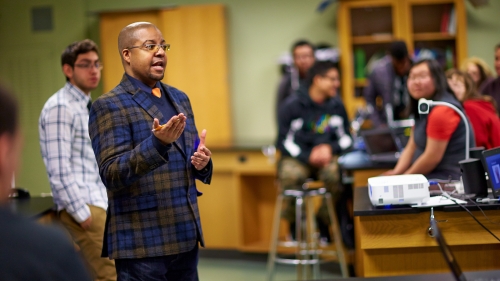US classrooms are becoming increasingly multilingual, with students from various language backgrounds. To meet the needs of these multilingual students, many teachers are adopting a pedagogy that encourages students to use all their languages in the classroom.
This teaching approach leverages multilinguals’ translanguaging – their ability to move fluidly between languages – for communication and learning. New research led by Associate Professor of Language Education Kongji Qin outlined the various ways that translanguaging can be used in a classroom, including to facilitate learning and foster bonds as well as isolate or insult others who don’t share a language. In these multilingual classrooms, a shared language among people can promote shared identity, bonding, and support. It can also be used for exclusion and aggression.

Qin’s co-authored article, published in The Modern Language Journal, drew on a case study his research team conducted in a high school science classroom where students’ languages included Spanish, Chinese, Bengali, and Arabic. The teacher in the case study spoke English as his first language and had an intermediate proficiency in Spanish and a beginner’s proficiency in Chinese. This research project was funded by the Spencer Foundation.
Through observation, audio and video recordings, and interviews with the teacher and students, Qin and his co-author, Vice Dean of Academic Affairs and Professor of Education Lorena Llosa, identified varied uses of translanguaging in this multilingual classroom:
- Translingual support: acts (between teacher and student or among students) that support students in accessing the instruction or negotiating meaning
- Translingual caring: acts that show care or make students more comfortable by speaking their first language, particularly when students are experiencing moments of vulnerability
- Translingual critical love: acts as a critical languaging practice for short-circuiting racism and countering inequality related to language use
- Translingual bonding: acts that work to develop and strengthen social relationships among students, either within or across language groups
- Translingual safe houses: acts that allow students to bypass surveillance to create a safe space for themselves, for having a laugh, resisting school power structures, or defying classroom rules or teacher control
- Translingual exclusion: acts that work to exclude people from other language groups
- Translingual aggression: acts that derogate or demean other people along the lines of differences, often in the form of racism, misogyny, and linguicism.
NYU News spoke to Qin and Llosa about the practice of translanguaging, the contributions of their research, and their suggestions for how to curtail negative uses.
Why is translanguaging important for the education of multilingual students?
First, translanguaging disrupts the deficit lens that views multilingual students as lacking English language proficiency; instead, it views them as multilingual speakers who can use their linguistic resources from all the languages they know for learning. Thus, translanguaging pedagogy embraces an asset-based approach to multilingual students. Secondly, by encouraging multilingual students to use their multilingual resources for learning, translanguaging pedagogy challenges monolingual ideologies and asserts that multilingualism is the norm, which works to affirm multilingual students’ linguistic and cultural identity. Third, translanguaging pedagogy allows teachers to make their instruction more accessible to multilingual students and allows them to use all their linguistic resources to demonstrate their academic learning and understanding.
How does your study contribute to the research on translanguaging pedagogy?
Few studies have acknowledged the complexity of translanguaging pedagogy. As educators, we need to ask: besides its benefits, what challenges does translanguaging pedagogy bring to the classroom? Our study examined both its affordances and challenges. We illustrated that in addition to its benefits, sometimes students used translanguaging to exclude other students. Such translingual exclusion often happened in group activities where students from the same linguistic background interacted with each other in their shared language, leaving out those from a different linguistic background. More critically, our study identified instances of translingual aggression – students sometimes used translanguaging to put down and discriminate against other students. These acts are more vicious because they are often left unchecked. By shedding light on its challenges, our study contributes to the research with a balanced view of translanguaging pedagogy that illuminates its complexity. Such a complex view can better inform teachers in using this instructional approach to advance educational equity for multilingual students.
Your article calls for using a lens of criticality toward translanguaging in classrooms. What does a lens of criticality mean and why is it necessary?
Taking up a lens of criticality means that language should not be just viewed through a neutral lens as only serving the purpose of exchanging information or communication; instead, we should attend to the relationships of language and power. Language often influences power relations and it is also influenced by power relations. It is important to take up a lens of criticality toward translanguaging in classrooms because as a theory of language, translanguaging challenges the power relations or the hierarchical relationships among languages created by monolingual ideologies. Relatedly, it also disrupts deficit views toward multilingual students. Yet, as previously mentioned, our study also showed that translanguaging was used by students for exclusion and aggression, such uses result in inequalities. Therefore, adopting a lens of criticality allows us to gain a comprehensive understanding of this approach – how it challenges power and inequality and how it might perpetuate inequality when used uncritically.
How can teachers curtail negative uses of translanguaging?
Teachers should develop students’ critical language awareness – awareness of how language is connected to power and inequity – so that they can move away from translingual exclusion and aggression. Once students develop such critical awareness, they will be able to become more conscious of their language use and its impact. A variety of approaches can be used to foster students’ critical language awareness. Teachers can ask students to do a survey to see what languages their peers speak in the classroom and discuss the relative positions of their class’s languages in hierarchies of power. Teachers can help students understand that translanguaging practices, like any language use, are connected to and often shape power and ideologies. Teachers can also engage students in critical reflection of when and with whom they use translanguaging, and why, as well as how their translanguaging might impact others in the context.

